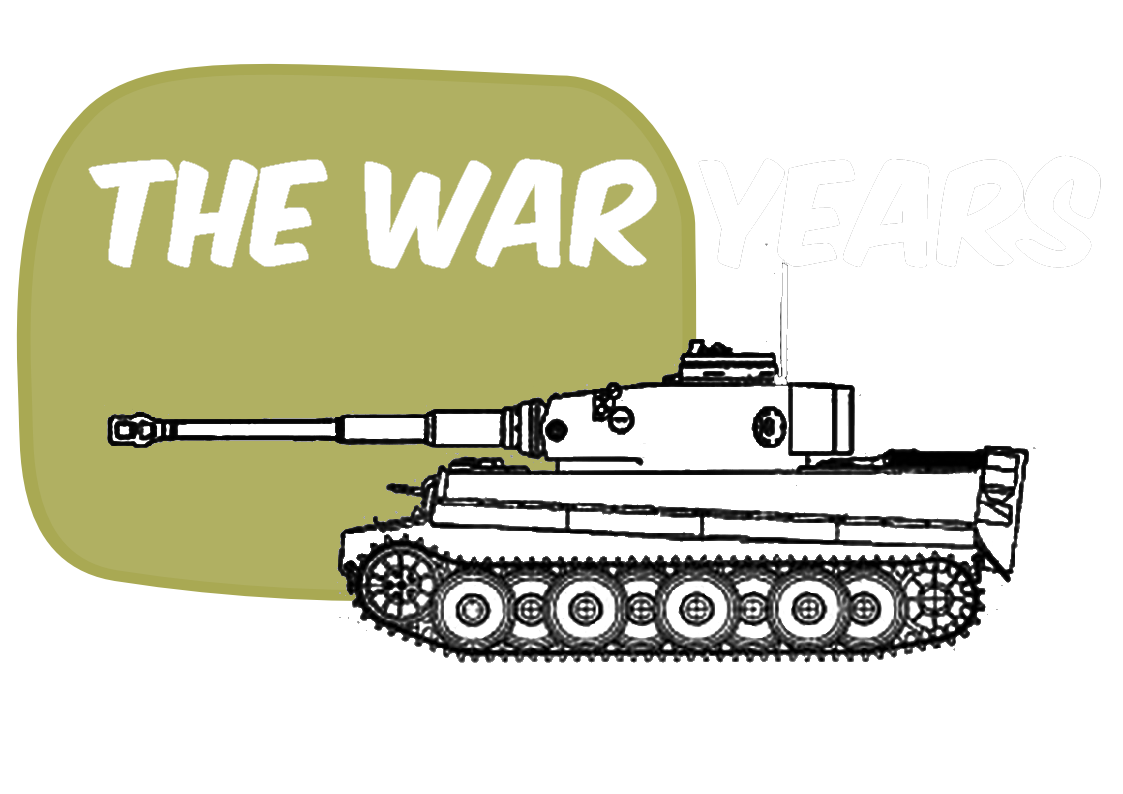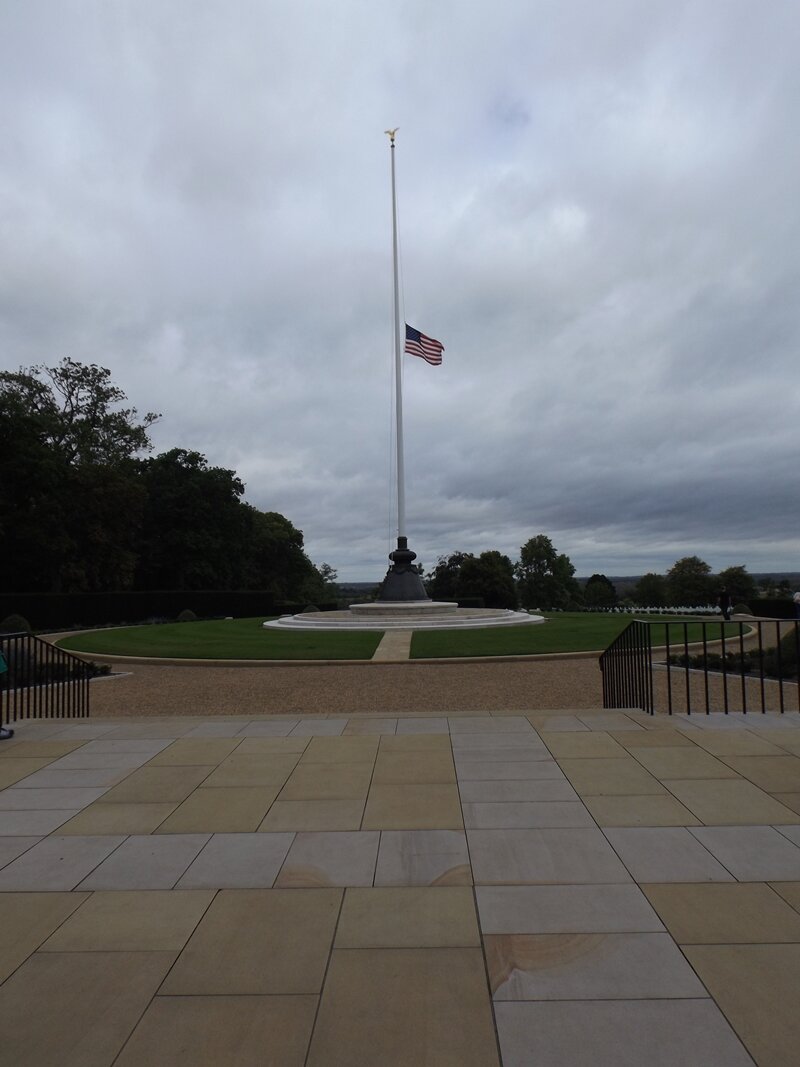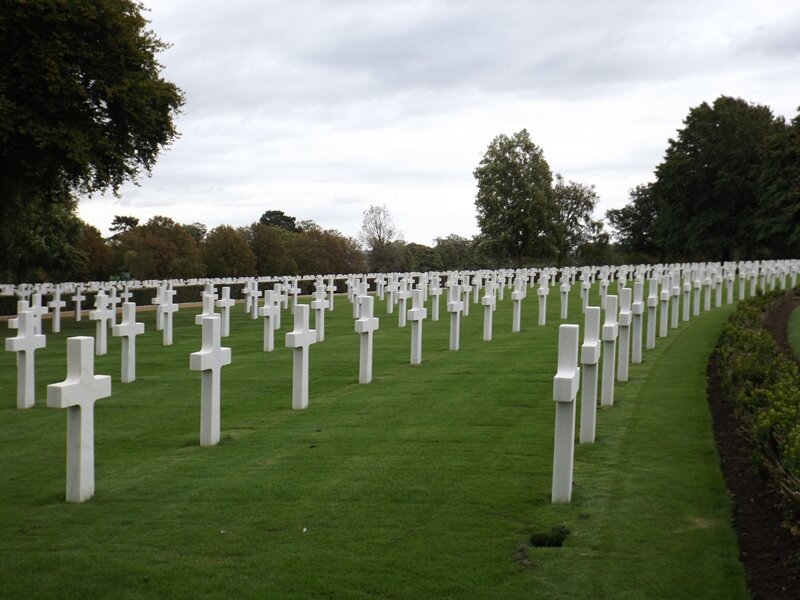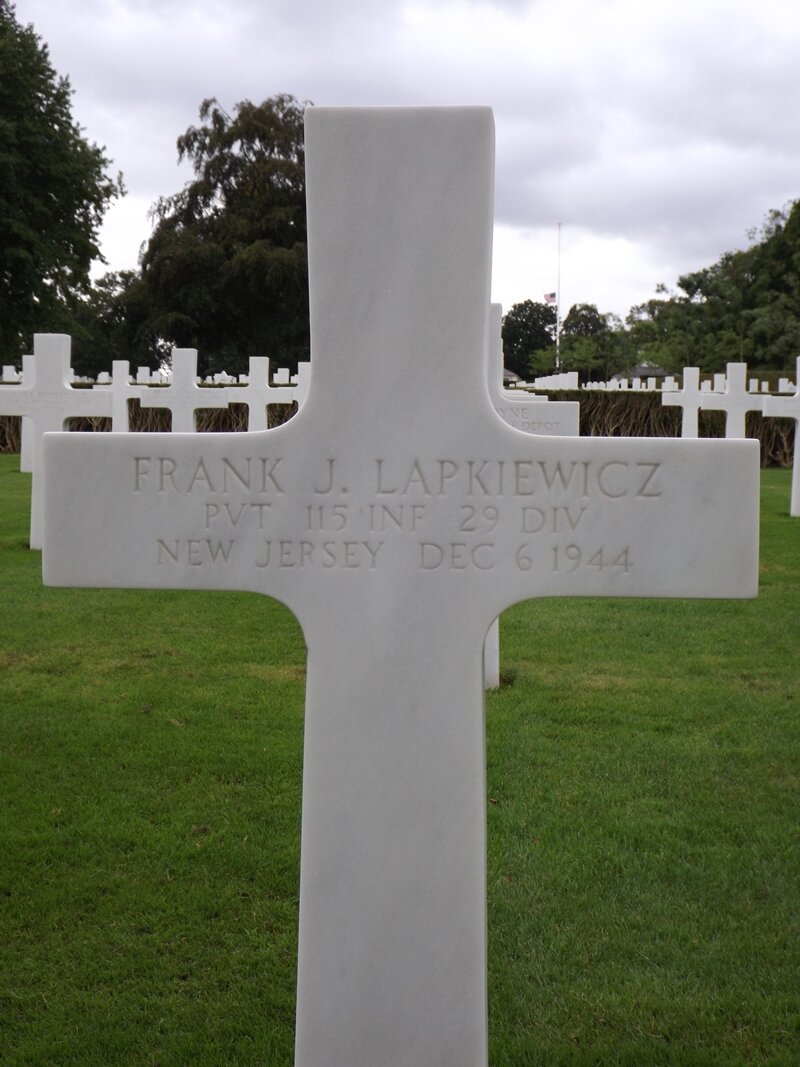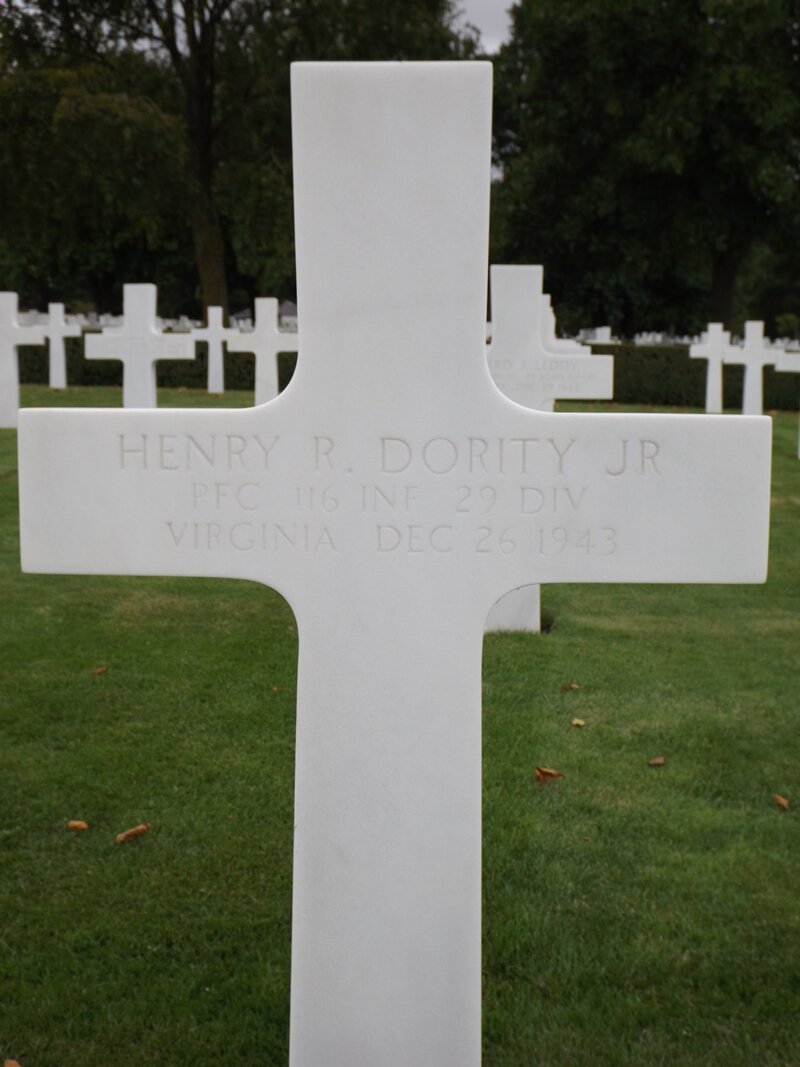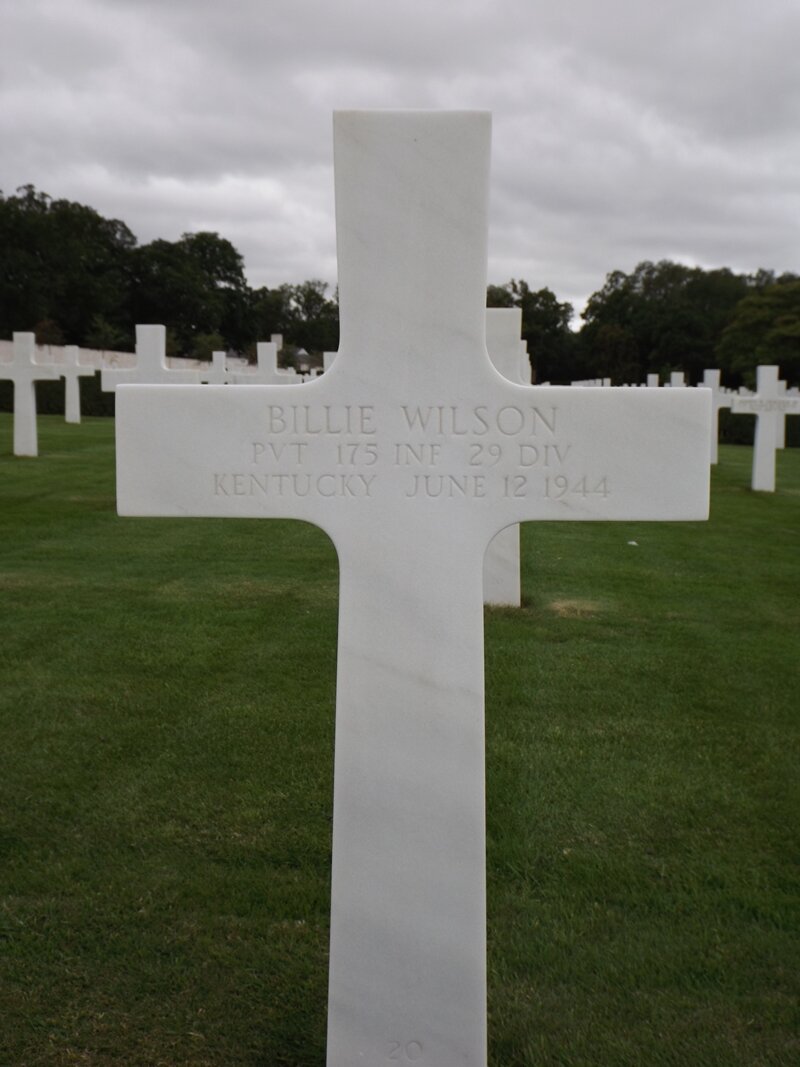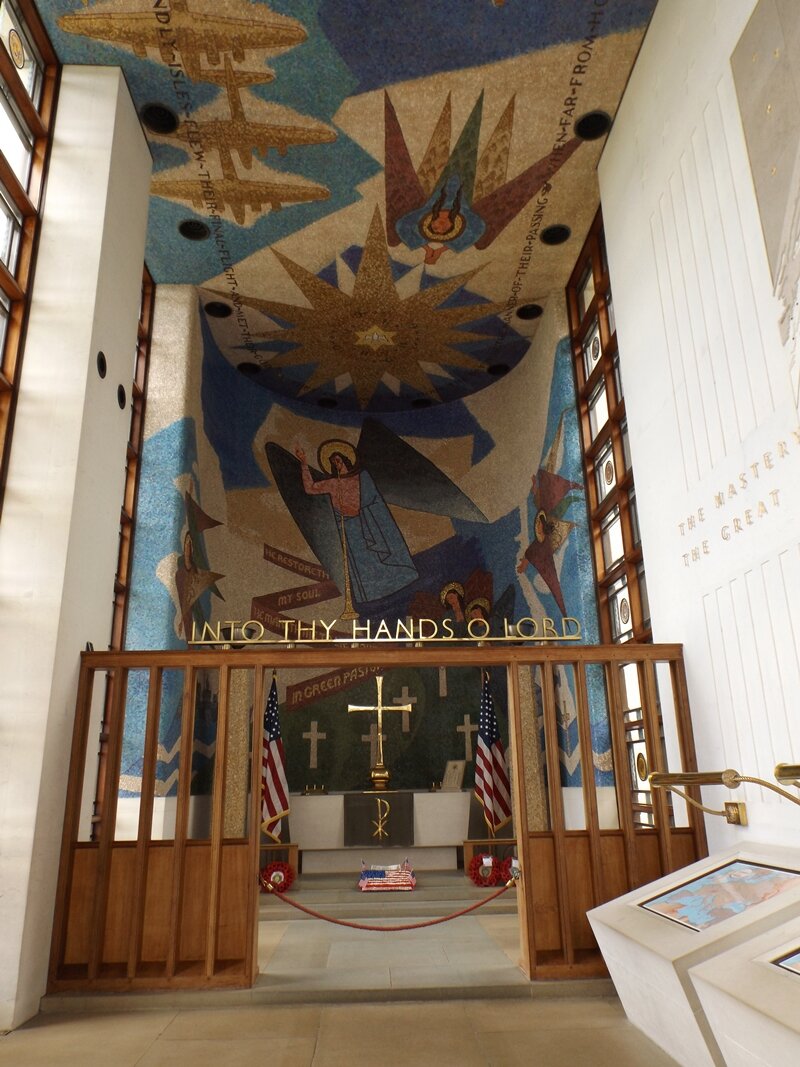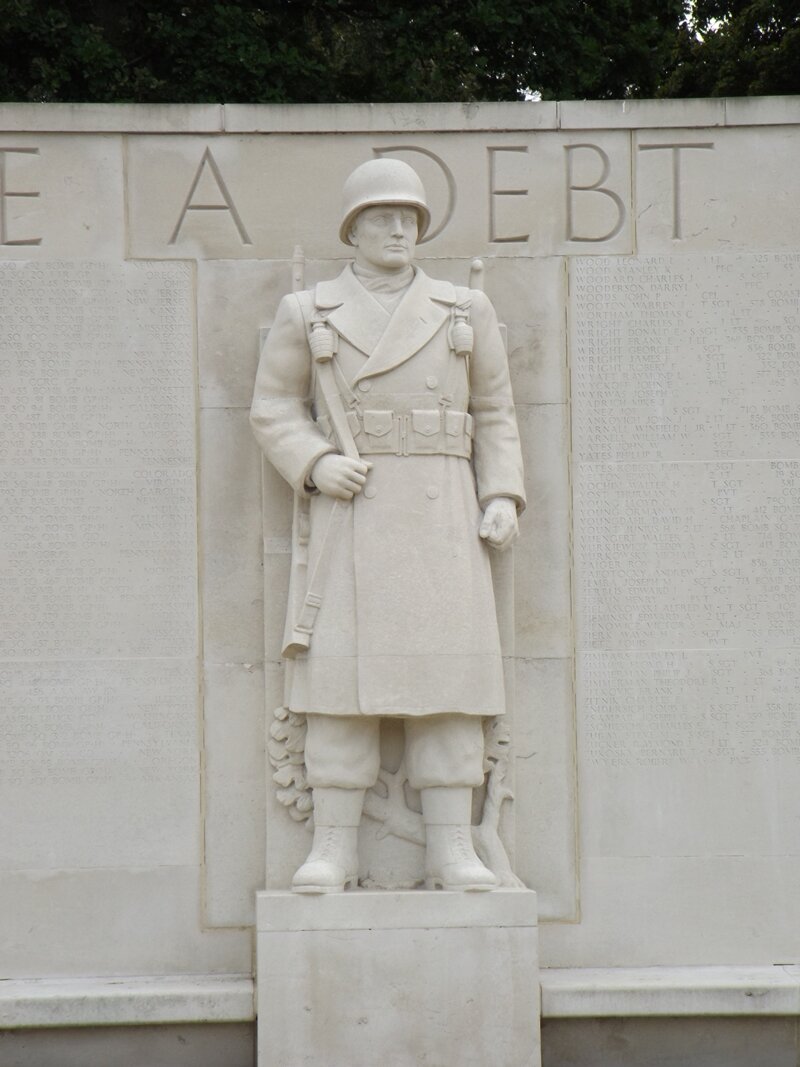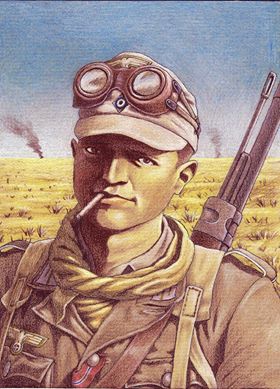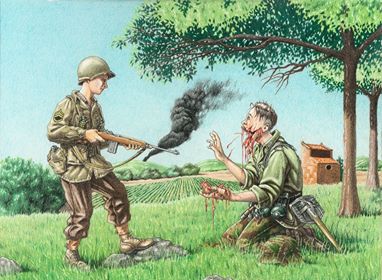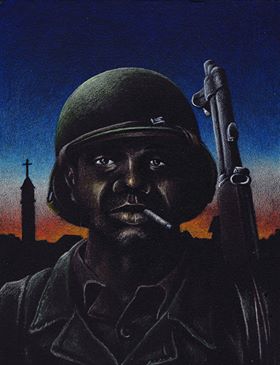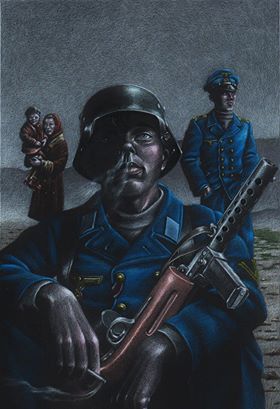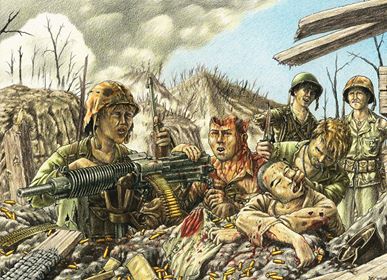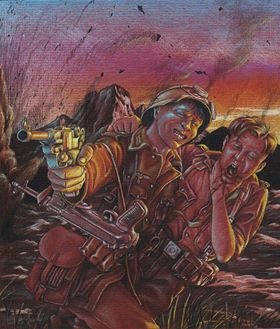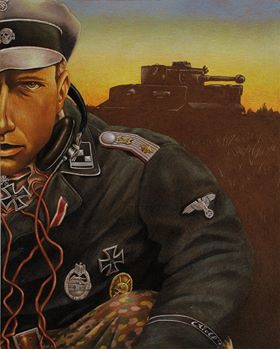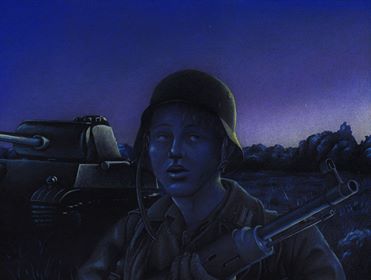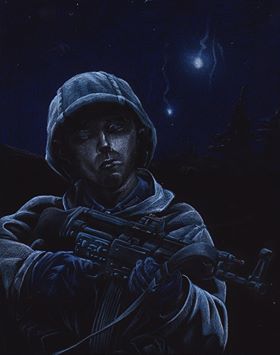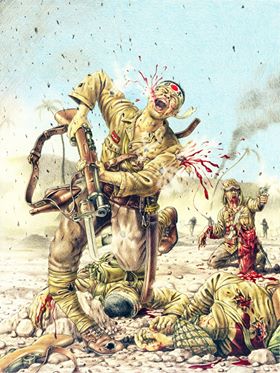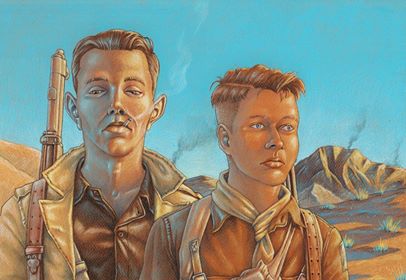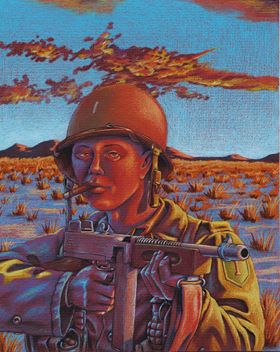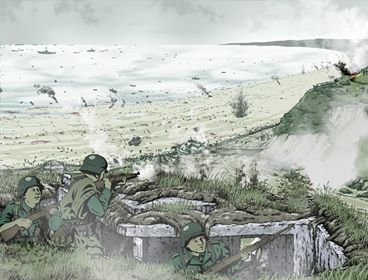
Blog
The Second World War resulted in the deaths of around 85 million people. Additionally, tens of millions more people were displaced. However, amid all the carnage, people demonstrated remarkable courage, fortitude, compassion, mercy and sacrifice. We want to honour and celebrate all of those people. In the War Years Blog, we examine the extraordinary experiences of individual service personnel. We also review military history books, events, and museums. We also look at the history of unique World War II artefacts, medals, and anything else of interest.
Cambridge American Cemetery and Memorial
In this blog post, we visit the Cambridge American Cemetery and Memorial. The Cambridge American Cemetery and Memorial holds the graves of 3, 812 soldiers, sailors and airmen. Another 5, 127 souls are commemorated on the Tablets to the Missing. During a recent visit to the Cambridge American Cemetery and Memorial I came across the headstones of three members of the US 29th Infantry Division, and decided to investigate.
Known as the “Friendly Invasion”, 1.6 million American service personnel were stationed in the UK by 6 June 1944. Three months after D-Day, 1.2 million of those Americans had been committed to battle. Of course, Americans had been supporting Britain from the very start of the Second World War from the famous Eagle Squadrons to US Navy and Merchant Marine. The US Eighth Airforce bombed targets across Occupied Europe and Germany from August 1942 to May 1945. By the end of the conflict, over 3 million Americans had been sent to Britain. Regrettably, many ground, naval and air force personnel would never return home.
The American Battle Monuments Commission operates and maintains 26 American military cemeteries and 29 monuments across 16 countries. There are two American military cemeteries in the UK, situated in Cambridge and Surrey. The Cambridge American Cemetery and Memorial hold the graves of 3, 812 soldiers, sailors and airmen. Another 5, 127 souls are commemorated on the Tablets to the Missing.
During a recent visit to the Cambridge American Cemetery and Memorial, I came across three members of the US 29th Infantry Division. As an associate member of the 29th Division Association, I took photos of each headstone so that I could do a little research about these men. In the case of PFC. Henry R. Dority, Jr, 116th Infantry Regiment, 29th Infantry Division, it seems likely that he was killed in a training accident or succumbed to some sort of illness. The 116th Infantry Regiment had started amphibious assault training on the English coast by the date of this death, December 26th, 1943.
Henry R. Dority, Jr
YOB: 1920
Home: Halifax, VA
Occupation: Semi-Skilled Painter, Construction or Maintenance
Marital Status: Single with dependents
Enlisted: 3 February 1941
Service No: 20364712
Private First Class, 116th Infantry Regiment, 29th Infantry Division
DOD: 26 December 1943
Private Billie Wilson must have been badly wounded during the initial bitter fighting for the beachhead following the D-Day landings. Billie’s unit, Company L, 3rd Battalion, 175th Infantry, landed on Omaha Beach, Normandy, on 7 June 1944, D+1. Their landing was opposed. On 8 June, the 1st battalion passed through and captured La Cambe. However, the 2nd and 3rd Battalions were strafed by RAF Typhoon fighter-bombers with six men killed and 16 wounded. It is possible that Billie was wounded during the blue-on-blue attack by Allied planes. There was some opposition at the start of the push into Isigny. The operation did not start until dusk. Once again, it is possible that Billie was wounded and reported missing during the night advance on Isigny. The 3rd Battalion supported by tanks took Isigny only to find it abandoned by the Germans and set on fire by Allied bombing. We do know that Billie was seriously wounded, returned to the UK and subsequently died of his wounds on 12 June 1944. On 9 June, 175th pushed through Isigny and supported by tanks secured a bridge over the Vire River. The regiment then consolidated around Lison on the 9 and 10 June 1944.
Billie Wilson
YOB: 1923
Home: Kentucky
Occupation: General Farmer
Marital Status: Single
Enlisted: 1 June 1942
Service No: 15114820
Private, Company L, 3rd Battalion, 175th Infantry Regiment, 29th Infantry Division
Reported missing in action on 8 June; dropped rolls on 21 June
DOD: 12 June 1944
Awards: Purple Heart
Frank J. Lapkiewicz joined Company E, 115th Infantry Regiment on 4 September from the replacement depot as a Rifleman. On 16 September, Frank was listed as lightly injured in action (LIA) and moved to the hospital. In November 1944, the 29th Infantry Division began its drive to the Roer River, Germany, blasting its way through Siersdorf, Setterich, Durboslar, and Bettendorf, and reaching the Roer by the end of the month. Frank returned to duty on 14 November. The attack on Durboslar, preceded by an artillery barrage, started on 19 November. The 2nd Battalion, 115th Infantry advanced on the town supported by tanks and artillery. In response, the Germans brought up 12 self-propelled 88mm guns. Two Allied airstrikes helped to dislodge the German defenders. Small unit actions continued into the night and the 115th took a number of prisoners. At some point during the fighting on the 19, after just five days back in the line, Frank was seriously wounded. Frank was evacuated back to the UK but died of his wounds on 6 December 1944.
Frank J. Lapkiewicz
YOB: 1915
Home: 1111 Maple Street, Wilmington, Delaware
Parents: Leon & Nellie Lukiewska
Occupation: Skilled worker in manufacturing
Marital Status: Single
Enlisted: 28 February 1944
Service No: 42085191
Private, Company E, 2nd Battalion, 115th Infantry Regiment, 29th Infantry Division
Wounded during the battle for the German town of Durboslar
DOD: 6 December 1944 (Died of Wounds)
Awards: Purple Heart
In total, the Cambridge American Cemetery and Memorial contain the graves of around 45 members of the 29th Division’s three infantry regiments. The American Battle Monuments Commission keeps the cemetery in immaculate condition. The visitors centre and helpful staff ensure that the stories of service personnel such as Henry, Billie and Frank are preserved and their sacrifices remembered.
Donald A. McCarthy, A Veteran’s Story
In this post, we tell the story of D-Day veteran Donald A. McCarthy, who served with Headquarters Company, First Battalion, 116th Infantry Regiment, 29th Division, and landed on Omaha Beach.
In 1999, I was researching the D-Day landings for a radio project. As part of my research, I was lucky enough to start corresponding with 29er veteran, Donald A. McCarthy. Sadly, Donald passed away in 2017 at the grand age of 93. He lived a full and active life. He was rightly proud of his military service. He was Commander of the 29th Division Association from 1995-96 and made 14 trips back to the Normandy beaches and battlefields. In 2014, he was awarded the French Foreign Legion of Honour. As part of the 75th anniversary of D-Day and battle for Normandy, I thought it worth sharing Donald’s own experience of landing on Omaha Beach as he told it to me.
Training for D-Day
I was a member of Headquarters Company, First Battalion, 116th Infantry, 29th Division. I was drafted in July 1943 after graduating from High School. I completed basic infantry training in Alabama, shipped overseas on the Il de France, assigned to 1BN 116t RCT at Ivybridge, 26 January 1944. The RCT (Regimental Combat Team) began intensive training at the Assault Training Centre, Woolacombe Beach on the North West Coast of Devon, and later in April participated in Exercise Fox at Slapton Sands. We were fortunate to have preceded the horrible debacle of Exercise Tiger of 27th April.
Omaha Beach
Again, I was fortunate to have survived the landings of the third wave at Omaha Beach. Although the flotilla was originally scheduled for Dog Green sector of the beach, the British Coxswain and the entire flotilla of LCAs (Landing Craft Assault) from the SS Empire Javelin (Infantry Landing Ship, Large) were carried in an easterly direction by the tide toward the Dog Red sector and the Moulin Draw.
My LCA had taken on water, was swamped and sank about 200 yards from the low watermark and beach obstacles. Several of us swam in behind bodies and attempted to hide behind the obstacles from machine gun and artillery fire. Although the MG fire was intense, the Germans on the bluff were unable to see us because of smoke from burning grass and buildings blowing east from the Vierville (Vierville-sur-Mer) area. The smoke screen provided an opportunity to run from the water’s edge, and the fear of getting run down from incoming landing craft, and find protection from the high water shingle.
Evacuation
Some of us managed to crawl toward the Vierville Draw and were eventually able to move up the draw and reach our objective, the church in Vierville. We came under fire from our own navy and I was ordered to return to the beach and attempt to contact the US Navy beach master. I was hit by an overhead shell burst in my left leg after finding a radio. The radio caught the brunt of the burst and both my leg and the radio became inoperative. A medic dragged me to a makeshift slit trench near the shingle within 100 yards of the draw. The following morning hundreds of us managed to walk towards the Moulin Draw and most were evacuated on LSTs (Landing Ship, Tank) back to ports in Britain. Some of us recovered and returned to Normandy within three weeks.
Wounded Again
I was able to re-join my company by early July and participate in the battle for St. Lo and Vire. During the attack at Vire, I came under heavy fire in an abandoned garage. The roof collapsed and debris hit my hand and neck. I did not consider my wounds serious until a form of blood poisoning finished my days with the 116th in France.
After several weeks in a General Hospital at Great Malvern, I was assigned to an Infantry Training Centre at Tidworth Barracks. We ran a training facility for Air Force personnel and shipped them to Holland and Germany as infantrymen.
Home
I remained a PFC (Private First Class) throughout my time in the ETO (European Theatre of Operations). In January 1946, I returned home to Boston and enrolled in college. I got married and worked for Bell Systems for 30 years. My work with Bell Systems centred on defence telecommunications with the US Navy including a period in Vietnam between 1967 and 1968. After leaving Bell, I worked for the Chamber of Commerce in Providence, Rhode Island. In 1969, I returned to England, chartered a small sailboat at Gosport, and sailed to Omaha Beach to recapture the event that changed my life. Since then I have returned to Normandy to take part in D-Day anniversary events with many other 29ers.
-END-
Visit the 29th Division Association website to learn more about the unit’s contribution during World War Two. Additional material courtesy of US Department of Veteran Affairs and Back to Normandy website.
D-Day 75: Daks Over Duxford
Watch our highlights video of the IWM Duxford’s Daks Over Duxford event as part of the 75th-anniversary commemorations of the D-Day landing of June 6 1944. The largest collection of Douglas C-47 Skytrain and DC-3 aircraft since World War Two. Ten aircraft flew sticks of paratroops over to Normandy for a mass parachute drop. We have also published 57 photos from the Daks Over Duxford event.
As part of IWM’s D-Day 75th anniversary week, Daks over Duxford told the extraordinary story of D-Day, uniting the greatest number of Douglas C-47 Skytrain and Dakota aircraft in one location since the Second World War. Synonymous with the D-Day Landings, more than 30 'Daks' descended upon IWM Duxford.
Mass parachute jumps and flight displays took place across the museum ahead of the epic cross-channel flight to Normandy on 5 June. On the ground, D-Day-related displays and activities brought the extraordinary story of D-Day to life.
In fact, 21 DC-3s and Douglas C-47s finally went to Normandy, ten of the aircraft carrying sticks of paratroopers for a mass drop as part of the Daks Over Normandy commemorations across the Channel. In reality, 1200 Douglas C-47s were used for D-Day. As well as the Daks, a P-47 Thunderbolt, two Mk 9 Spitfires and two P-51 Mustangs performed aerial displays. There was also a very impressive flypast by a collection of USAF C-130s and V-22 Osprey modern aircraft.
DDay 75: Daks Over Duxford Photography
D-Day 75th Anniversary Commemoration
As part of the D-Day 75th-anniversary commemorations, The War Years will be adding a range of content over the coming week.
As part of the D-Day 75th-anniversary commemorations, The War Years will be adding a range of content over the coming week.
The Story of D-Day, Part One
The Plan
The largest amphibious operation in military history, code-named Overlord, D-Day started in the early hours of 6 June 1944. The objective was an 80 km stretch of the Normandy coastline. An armada of 7000 ships planned to land 175,000 men, 50,000 vehicles and all their equipment by day’s end. 11,000 aircraft, oil pipelines under the English Channel and even giant Mulberry Harbours would be towed across the sea.
Neptune
Operation Neptune was the naval element of the Overlord plan. 7,000 vessels from battleships to landing craft, Neptune was truly an allied effort. British, American, Canadian, French, Norwegian, Dutch, Polish and Greek vessels all played a part in enabling the landing’s success.
The Landings
The Allies planned to land on 5 beaches code-named Utah, Omaha, Gold, Juno and Sword. The flanks or sides of the planned beachhead would be secured by airborne forces dropped during the night and early morning on 5/6 June.
Pegasus Bridge
Strategically important, the bridges over the Caen Canal and Orne River had to be captured to enable Allied tanks to operate east of the river, and prevent German counter-attacks against the landings.
Seized by a daring glider assault the bridges were successfully captured by Major John Howard’s D Company, 2nd Battalion, Ox and Bucks Light Infantry at just after midnight, 6 June 1944. Once captured it was vital Major Howard’s men held the bridges against counter-attacks until relieved by Lord Lovat’s 1st Special Service Brigade at 1 pm.
Merville
In the area immediately east of Sword Beach, some 4,800 elite airborne troops landed by parachute and glider. Men of the 9th Parachute Battalion took the German coastal battery at Merville that threatened the British landing beaches.
US Paratroops
The American 82nd and 101st Airborne Divisions secured the flanks of the US beaches. However, the 6,600 men dropped were badly scattered that reducing their initial effectiveness, although this did confuse the German defenders. The paratroopers successfully secured the exits from Utah Beach and captured bridges en route to Carentan.
The Story of D-Day, part Two
The American Beaches
Utah Beach
The D-Day landings started at the low water mark on a rising tide at 06.30hrs in the US sector and 07.30hrs for the British.
Strong coastal currents and obscuration of landmarks due to smoke from naval bombardment meant American invasion forces landed 2,000 yards south of their planned objective on Utah Beach. Luckily the area where troops from the 4th Infantry Division actually landed was less heavily defended, and casualties were mercifully light.
Pointe du Hoc
Just as Pegasus Bridge was vital to the success of the British landings so Pointe du Hoc was important to the Americans. Intelligence reports prior to the landings indicated that six 155mm guns in concrete emplacements sat atop a 177ft cliff. The guns threatened the landings on Utah and Omaha Beaches and had to be destroyed.
The elite 2nd Ranger Battalion was tasked with destroying the guns at Pointe du Hoc by direct assault from the sea, which meant scaling the cliffs while under fire. However, when the Rangers fought their way up to the gun emplacements they found them empty. The guns had been moved inland. Later, the guns were found and destroyed.
Omaha Beach
The most difficult terrain and heavily defended sector, Omaha Beach was the objective of the US 1st and 29th Infantry Divisions. At 5.40 am amphibious DD tanks launched 6,000 yards offshore, nearly all sinking in the heavy seas.
Only 5 tanks made it ashore to support the infantry landings. All but one of the 105mm field artillery guns also vital to the landings were lost. To make matters even worse, the naval and air bombardment had done little to reduce the German defensive positions commanding the exposed beach.
Seasick, heavily laden, troops of the nine companies in the first assault wave were decimated by German machine-gun, mortar and artillery fire. Those troops lucky enough to make it across the open beach took cover behind the sea wall.
The assault on Omaha initially stalled. However, gradually men formed small groups and started fighting their way up the bluffs that overlooked the beach. Later, navy destroyers came dangerously close to shore to give much-needed fire support. By day’s end, Omaha Beach was in American hands.
Brigadier General Norman “Dutch” Cota, several NCOs and Privates received decorations for gallantry during the action at "Bloody Omaha".
Today, 3 June 2019, we post a short video taken back in June 2010 on a visit to Omaha Beach and the American Cemetery and Memorial.
The Story of D-Day, part Three
The British, French and Canadian Beaches
Gold Beach
Westernmost of the British/Canadian beaches, code-named Gold, were assaulted by the 50th Division of the British XXX Corps. Specially developed armoured vehicles were landed ahead of the infantry to deal with beach obstacles, mines and the sea wall. Some 2,500 obstacles and mines needed to be cleared from Gold Beach alone. Allied forces quickly overcame German defences and moved inland.
During the advance of the 69th Brigade, Company Sergeant Major, Stan Hollis of the Green Howards won the Victoria Cross, for repeated acts of valour, Britain’s highest military honour. This was the only VC won on D-Day.
Juno Beach
Canada made a terrific contribution to the Allied war effort. Juno Beach was assigned to the Canadian 3rd Division. Like the British, the Canadians used special armoured vehicles to help overcome beach obstacles, mines and strong points. These vehicles were nick-named Hobart’s “funnies” after their creator Major General Sir Percy Hobart.
The town of Courseulles was strongly defended by the Germans but duly taken. The Queens Own Rifles suffered severe casualties crossing the beach at Bernieres. The Canadians made contact with 50th Division on their right by day’s end.
Sword Beach
The easternmost landing zone, Sword Beach, was assaulted by the British 3rd Division. The 3rd Division’s objectives were perhaps the most ambitious of the D-Day operation: capture or mask the Norman city of Caen by nightfall. The 3rd Division also knew it was likely to be counter-attacked by tanks of the German 21st Panzer (Armour) Division.
British intentions to quickly move off Sword Beach and drive inland were held up by resistance from German strong points. British troops reached Lebisey Wood, just three miles short of Caen, but could advance no further.
Special Forces - The Commandos
French Commandos led by Philippe Kieffer took Ouistreham casino and secured the canal gateway. However, the French suffered heavy casualties and Kieffer was wounded twice during the fighting.
Commandos of the 1st Special Service Brigade landed on the 'Queen Red' sector of Sword Beach at approximately 8.40 am, 6 June 1944. Commanded by Brigadier Simon Fraser, Lord Lovat, the 1st Special Service Brigade’s mission was to push inland and link up with the lightly armed British 6th Airborne Division holding Pegasus Bridge and bridge over the Orne River.
Today, we have added 241 photos to our Flickr site taken during visits to the D-Day beaches, Pegasus Bridge Memorial and Museum, Normandy American Cemetery and Memorial, Omaha Beach Memorial Museum, Airborne Museum, Sainte-Marie-du-Mont and Sainte-Mère-Église in 2010 and 2014.
WW2 Artwork of Michael Akkerman
In this blog post, we showcase the emotive, World War Two-inspired artwork of Michael Akkerman from the famous faces of Audie Murphy and Eugene Sledge to the bloody realities of the battlefield.
Michael Akkerman is an American artist whose work is heavily influenced by World War Two (WW2) military history. Michael has kindly allowed The War Years to show some of his work here. Probably the most recognised subject of Michael’s work is Hollywood legend, Audie Murphy. He was one of the most decorated American soldiers of WW2, winning the Medal of Honor aged 19. After the war, Murphy had a successful acting career, as a songwriter and horse breeder. Sadly, he was killed in a plane crash in 1971. He was only 45 years old. One of Michael’s pictures is inspired by an episode taken from Murphy’s wartime autobiography, where he felt compelled to shoot a badly wounded young German soldier as an act of mercy.
Eugene Sledge is another name that will be familiar to many people with a passing interest in the Second World War. He served in the US 5th Marines, 1st Marine Division fighting in the Pacific. His book, ‘With the Old Breed: At Peleliu and Okinawa’ became a bestseller when published in the 1980s. His book and Robert Leckie’s ‘Helmet for My Pillow’, also served as inspiration for the HBO miniseries The Pacific. The savage, relentless fighting of the Pacific campaign had a dehumanising effect on many of the combatants. However, somehow, Eugene Sledge was able to hold onto his humanity amidst the horror, which is vividly illustrated in Michael Akkerman’s artwork.
Made famous by Nazi propaganda and a legend by the battle of Villers-Bocage, Michael Wittmann was a German tank ace with an impressive tally of 138 kills, mainly achieved on the Russian Front. He is also the subject of one of Michael Akkerman’s paintings. A week after the D-Day landings, SS-Hauptsturmführer Wittmann and his Tiger tank bumped into the forward elements of the British 7th Armoured Division. Wittmann attacked the British column and destroyed 14 tanks, 15 personnel carriers and two anti-tank guns in an engagement that lasted about 15 minutes. Wittmann was awarded the Knight's Cross with Oak Leaves and Swords and became a propaganda star. However, he would be killed just two months later. His remains would not be found and positively identified until 1983.
As well as the famous and infamous, Michael Akkerman’s paintings capture some of the more mundane and human elements of the Second World War, from the black ‘Buffalo Soldiers’ of the US Army to the hardships of the North Africa campaign. He also depicts the bloody realities of the Japanese Banzai charge and the lethal efficiency of the German MG-42 machine guns used to defend Omaha Beach on D-Day. To learn more about Michael’s artwork or to get a quote for a commission, you can find him on Facebook.
Book Review: Courage After The Battle by Peter Jackson-Lee
Courage After The Battle written by ex-Royal Marine and Falklands veteran Peter Jackson-Lee is a book that takes the reader on a journey that most people will never experience. The book is a travelogue that explains how service men and women navigate their way from battlefield injury back to civilian life. Read the full book review now
Courage After The Battle written by ex-Royal Marine and Falklands veteran Peter Jackson-Lee is a book that takes the reader on a journey that most people will never experience. The book is a travelogue that explains how service men and women navigate their way from battlefield injury back to civilian life. The book also examines the history of battlefield medicine, mental healthcare, prosthetics, reconstructive surgery, politics and changes in social welfare. At turns, the book is inspiring, fascinating and deeply troubling.
The book takes a systematic look at what happens to service personnel from the moment they suffer a life-changing wound on the battlefield. It explains the process of evacuation, emergency trauma care and transition to the hospital. Next, the book explains the many different types of battlefield trauma: loss of limbs, facial disfigurement, deafness and blindness. The book also looks at various treatments available such as prosthetics and plastic surgery. However, it is the long shadow cast by mental health and social care issues such as post-traumatic stress disorder (PTSD), depression, drug addiction, alcohol abuse and homelessness that I found the most disturbing. The destructiveness of these hidden wounds, if not treated quickly, spreads out like a pressure wave damaging family, friends and wider society.
The final third of Peter Jackson-Lee’s book explains the covenant between the Armed Services, the Nation and UK Government. The book also lists around 150 national charities and other organisations that provide help and support to current service personnel, veterans and their families. The fact that over 70 pages of the book simply list charitable organisations that offer support is alarming. It demonstrates the betrayal of the Armed Forces Covenant, and the abject failure of government policies stretching back decades. In many ways, this book is the story of a shocking, perennial national disgrace.
The book is written in a balanced, no-nonsense, straightforward style and tone. Peter Jackson-Lee lets the veterans, families, healthcare professionals, charity workers and facts speak for themselves. He explains the history of every technical, medical and procedural advance that makes suffering a battlefield injury move survivable. However, while the overall survivability of battlefield injuries has steadily increased, the opposite is true of long-term care. Consecutive governments have overseen punitive cuts in the provision of everything from mental healthcare to housing, and much more besides.
From Trafalgar, Waterloo and the Battle of Britain to the Falklands, Iraq and Afghanistan, the Armed Services have always been there to protect this country’s national interests with their lives. Nevertheless, the compact between the State and its servicemen and women has always been an unequal one. Service personnel are expected to make the ultimate sacrifice without complaint when called upon to do so. In contrast, our politicians, the Ministry of Defence (MOD) and civil servants can renege on every promise and betray every commitment. While our service men and women are driven by loyalty, courage and comradeship, the politicians and bureaucrats are driven by arrogance, ignorance and greed.
Reading Courage After The Battle makes you ask the question, why would anyone join the Armed Services? In 2018, a National Audit Office (NAO) report found the Armed Services had a shortfall of 8,200 regulars (full-time service personnel). In December 2018, it was widely reported that a £495m contract with the outsourcing giant Capita had clearly failed to achieve the Army’s recruitment targets. What’s more, half of the Army’s applicants subsequently dropped out of the process. Another monumental waste of public money that could have been better spent elsewhere.
Interestingly, a Harvard Institute of Politics (IOP) survey found that while many millennials (18 to 29 years old) generally supported the US military’s war against Islamic State (ISIS), they themselves did not want to take part. One reason many millennials gave for not wanting to join the US military was a “deep distrust about all things relating to the government.” Clearly, books like Courage After The Battle can help today’s young people make better-informed decisions about joining the military, and the potential long-term consequences of doing so. The book also shines a light on the many shameful actions perpetrated by British politicians, civil servants and bureaucrats against our veterans and their families. Something to think about the next time you go to the polls.
Courage After The Battle is published by Brown Dog Books.
